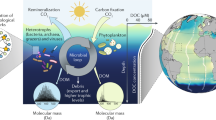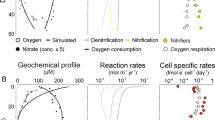Abstract
DISSOLVED organic matter (DOM) in the ocean is one of the largest active reservoirs of organic carbon on Earth. It is important to understand the processes by which DOM is recycled, particularly as changes in the oceanic DOM pool could affect atmospheric carbon dioxide concentrations on timescales of 1,000 to 10,000 years (ref. 1). It is commonly believed that low-molecular-weight material, which comprises 65-80% of DOM2–5, is rapidly remineralized, and that high-molecular-weight material is refractory. But the average age of DOM in the deep ocean is about 6,000 years (ref. 6) which implies that a large proportion of the DOM cycles only very slowly. Here we present a study of the relative bioavailability of low- and high-molecular weight DOM in water samples taken from the northern Gulf of Mexico during a diatom bloom. Bacterial growth and respiration in the presence of high-molecular-weight DOM were respectively three and six times greater than for low-molecular-weight material. Although both of these pools undoubtedly contain mixtures of compounds with varying reactivities and turnover times, our results demonstrate that the bulk of oceanic DOM comprises small molecules that cycle slowly and are relatively unavailabe to microorganisms.
This is a preview of subscription content, access via your institution
Access options
Subscribe to this journal
Receive 51 print issues and online access
$199.00 per year
only $3.90 per issue
Buy this article
- Purchase on Springer Link
- Instant access to full article PDF
Prices may be subject to local taxes which are calculated during checkout
Similar content being viewed by others
References
Hedges, J. I. Mar. Chem. 39, 67–93 (1992).
Benner, R., Pakulski, J. D., McCarthy M., Hedges, J. I. & Hatcher, P. G. Science 255, 1561–1564 (1992).
Kepkay, P. E., Niven, S. E. H. & Milligan, T. G. Mar. Ecol. Prog. Ser. 100, 233–244 (1993).
Ogawa, H. & Ogura, N. Nature 356, 696–698 (1992).
Carlson, D. J. Mar. Chem. 16, 155–171 (1985).
Williams, P. M. & Druffel, E. R. M. Nature 330, 246–248 (1987).
Oudot, C., Gerard, R. & Morin, P. Limnol. Oceanogr. 33, 146–150 (1988).
Graneli, W. A. E. G. Mar. Biol. 108, 341–348 (1991).
Benner, R. & Strom, M. Mar. Chem. 41, 153–160 (1993).
Chin-Leo, G. & Benner, R. Mar. Ecol. Prog. Ser. 87, 87–103 (1992).
Porter, K. G. & Feig, Y. S. Limnol. Oceanogr. 25, 943–948 (1980).
Tranvik, L. J. Appl. Envir. Microbiol. 56, 1672–1677 (1990).
Kirchman, D., K'Nees, E. & Hodson, R. Appl. Envir. Microbiol. 49, 599–607 (1985).
Lee, S. & Fuhrman, J. A. Appl. Envir. Microbiol. 53, 1298–1303 (1987).
Goldman, J. C., Caron, D. A. & Dennett, M. R. Limnol. Oceanogr. 32, 1239–1252 (1987).
Kirchman, D. L., Suzuki, Y., Garside, C. & Ducklow, H. W. Nature 352, 612–614 (1991).
Sambrotto, R. N. E. A. Nature 363, 248–250 (1993).
Toggweiler, J. R. Nature 363, 210–211 (1993).
Ittekkot, V., Brockmann, U., Michaelis, W. & Degens, E. T. Mar. Ecol. Prog. Ser. 4, 299–305 (1981).
Sakugawa, H. & Handa, N. Oceanologica Acta 8, 185–196 (1985).
Pakulski, J. D. & Benner, R. Limnol. Oceanogr. (in the press).
Wells, M. L. & Goldberg, E. D. Nature 353, 342–344 (1991).
Moran, S. B. & Buesseler, K. O. Nature 359, 221–223 (1992).
Hagström, A., Ammerman, J. W., Henrichs, S. & Azam, F. Mar. Ecol. Prog. Ser. 18, 41–48 (1984).
Williams, P. M. & Druffel, E. R. M. Oceanogr. Mag. 1, 14–17 (1988).
Hama, T. & Handa, N. Arch. Hydrobiol. 109, 227–243 (1987).
De Leeuw, J. W. & Largeau, C. in Organic Geochemistry: Principles and Applications (eds Engel, M. H. & Macko, S. A.) 23–63 (Plenum, New York, 1993).
Mayer, L. M. in Organic Geochemistry: Principles and Applications (eds Engel, M. H. & Macko, S. A.) 171–181 (Plenum, New York, 1993).
Harvey, G. R. Mar. Chem. 12, 119–132 (1983).
Whitledge, T. E., Malloy, S. C., Patton, C. J. & Wirick, C. D. Automated Nutrient Analyses in Seawater (Report No. 51398, Brookhaven National Laboratory, Upton, New York) (1981).
Benner, R. in Marine Particles: Analysis and Characterization (eds Hurde, D. C. & Spencer, D. W.) 181–185 (Geophys. Monogr. 63, American Geophysical Union, Washington DC, 1991).
Author information
Authors and Affiliations
Rights and permissions
About this article
Cite this article
Amon, R., Benner, R. Rapid cycling of high-molecular-weight dissolved organic matter in the ocean. Nature 369, 549–552 (1994). https://doi.org/10.1038/369549a0
Received:
Accepted:
Issue Date:
DOI: https://doi.org/10.1038/369549a0
This article is cited by
-
Microbial degradation of various types of dissolved organic matter in aquatic ecosystems and its influencing factors
Science China Earth Sciences (2023)
-
Viruses affect picocyanobacterial abundance and biogeography in the North Pacific Ocean
Nature Microbiology (2022)
-
Biodegradation and Photodegradation of Vegetation-Derived Dissolved Organic Matter in Tidal Marsh Ecosystems
Estuaries and Coasts (2022)
-
Rainfall and drainage basin shape strongly control temporal and spatial variation of dissolved organic matter in a tropical lake
Limnology (2022)
-
Enigmatic persistence of dissolved organic matter in the ocean
Nature Reviews Earth & Environment (2021)
Comments
By submitting a comment you agree to abide by our Terms and Community Guidelines. If you find something abusive or that does not comply with our terms or guidelines please flag it as inappropriate.



